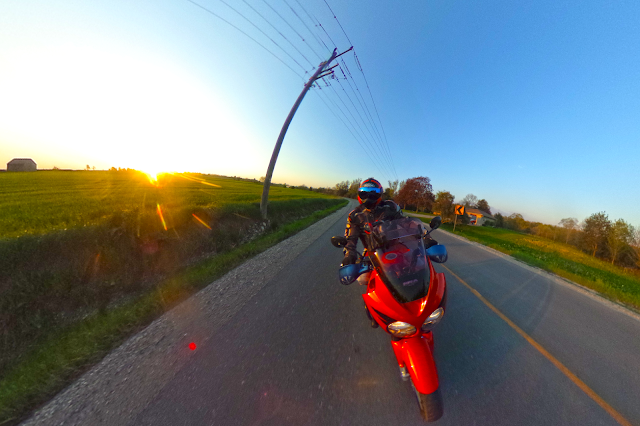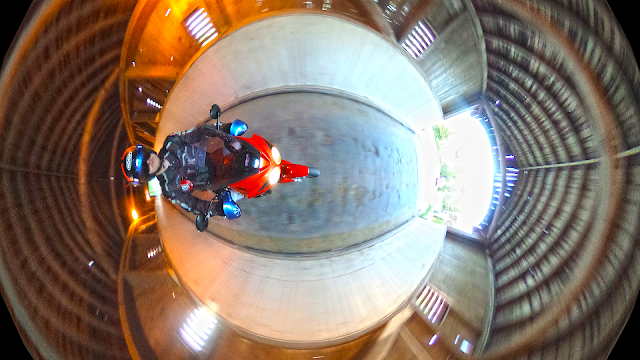Motorbikes are like sharks, they die if they aren't in motion. There is a funny moment in the
Bakuon!! motorcycle anime where the old motorcycle store owner talks about how lazy motorcycles are since they just lay down if no one is holding them up. So bikes are sharks that need people to keep them in motion.
The latest project bike is a fantastically complicated machine. I've
rebuilt fabulously complex sets-of-four-carburetors and chased down
other complex repairs in motorcycles, but I suspect this 2010 Kawasaki Concours C14/GTR1400 has single systems, like its
motorized windshield, that are more complicated than whole previous bikes I've worked on; this bike a complex mix of mechanical and digital engineering, and it's been sitting for several years when its previous owner could no longer give it the urge to stay in motion.

On the Concours the clutch slave cylinder uses brake fluid to hydraulically assist the clutch, giving you an even, assisted clutch action. I went for a long ride on the Tiger yesterday and I'm not ride-fit yet as it's still early in the season. The grip muscles in my left hand were singing by the end of the ride and I was getting lazy with gear changes as a result. A hydraulically assisted clutch would make long rides more comfortable, so there are benefits to this complexity.
This is the first bike I've owned that isn't a simple mechanical clutch that uses a cable tied to the transmission. On the C14 the clutch is on the lower right of the motor and the clutch and the slave cylinder it feeds is on the left. When you apply the clutch the brake fluid in the hydraulic system pushes a (very) long rod that runs right through the bottom of the motor over to the clutch. That long rod is coated in molybdenum disulfide grease and connects the hydraulic clutch slave system to the clutch itself over on the other side of the motor.
One of the parts diagram blowouts I was looking at called the 92026a a gasket, so I purchased that thinking that's where the leak was, but this isn't a gasket, it's a hard spacer. When you attach the clutch slave cylinder housing to the bottom left side (left and right is with the rider on the bike), this spacer isn't a seal and the bolts holding it on need locktite to keep them in place because they're only held on with 97 inch-pounds of torgue (which is little more than my hand tight). You don't want to crank on the bolts, you want to sympathetically install the housing to spec so the spacer isn't squashed and can do its job.
When I got into the clutch housing it was pretty grotty. This stationary shark has lots of little rubber bits in it that don't sit well, and the 92049 rubber piston seal has perished in the years the bike sat. The brake fluid that the clutch hydraulic system uses was leaking past the seal into the chamber with the rod in it, which is usually dry, and then leaking around the spacer.
In retrospect I should have looked over the shop manual more closely and wrapped my head around how the system works before I rushed in to buy a spacer I didn't need. I've contacted
Two-Wheel Motorsport to get the seal. They were very quick with a 2-day turnaround (impressive during Ontario's third-wave of Covid) and offer curb-side pickup, so I'm hoping by mid-week I'll have what I need to rebuild the clutch slave cylinder and get the clutch back to spec.
I'm now wondering if this leaking seal was the reason why it was such a pain in the ass to bleed last time - that certainly makes sense.
That clutch cylinder (gold) slides out and the seal and spring are easily accessed. You need to replace the seal if you remove the cylinder so make sure you've got one on hand if you're going to pop the cylinder out.
It's also recommended that you apply some rubber grease to the seal as you're installing it.
This stuff looks like it'll do the trick and is formulated specifically for a tough life immersed in brake fluid.
Interestingly, replacing this seal isn't in the clutch section of the shop manual but rather in the maintenance section, which suggests that these seals have a limited life-span and are a regular maintenance item. If you own a C14 you're probably going to be doing these at some point, especially if the bike sits for any time or you're not a regularly clutch fluid maintainer.
NOTES
Upper bleeder is 8mm, lower is 10mm.
part: SB8125# thread: M8 X 1.25 length: 1.10, (27.99)
part: SB8125L # thread: M8 X 1.25 length: 1.28, (32.54)
Online resources for Concours Speed Bleeders
Murph's Kits - but they are very US focused *5 each PN SB8125L, and 2 each PN SB8125*
FOLLOWUP
The installation of the seal is very straightforward. You can slide the cylinder out by hand and then remove the seal, which sits in a depression, very easily. The new one was a snugger fit when sliding it back in, which is probably why the old one was leaking. I coated the seal in this brake lubricant, which helped it slide in. Pushing evenly with the heel of my hand helped seat it straight. I also lubed up the rod that runs through the motor to the clutch with this moly grease.
The whole process took about 10 minutes and no more leaks. The clutch bled much more quickly and easily without the leak and the clutch feel is excellent now.
Getting the fairing back on required some fiddling as the previous owner's drop had bent the metal piece it attaches to and I'd fixed the cracks in the fairing so they all lined up true now. I ended up heating it up and bending it back to its usual position and it all went together. The bike's now ready for a safety but I'm having trouble getting a response from Lloyd, my usual go-to local mechanic. Hopefully I can get the paperwork in order and get it on the road next week.













































